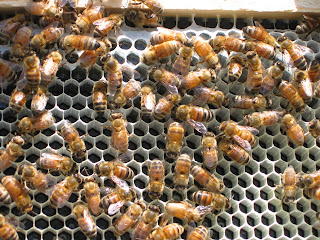Well, the first sting for me was this weekend. The colony has been incredibly docile, and I've taken to just a hat, no veil or gloves and now usually just shorts and a tshirt when I go down to do any work. But, I wanted to get a few pictures this time, and of course was paying a lot less attention to what I was doing and put the frames back in the box roughly, upset the bees and paid the price. So, I'll post the pictures but please remember the cost :-)


Monday, June 11, 2007
Stung
Posted by
Simon
at
7:10 AM
![]()
Bees and the pool
I know it's been a while since I posted anything but work and the garden have kept me busy. I am going to echo here a thread that's been discussed recently on the local beekeeper mailing lists, with a personal angle. How to keep the bees away from our pool. It seems bees like a water source that has a strong odor and Chlorine is one of those odors and so a pool becomes a great attraction. At first this was cool, we could watch the bees drinking from the edge, or from the string holding up the thermometer or drinking off the mat where people get in and out (which of course gets nice and wet). But, some days there's a lot of bees and sooner or later ....
It seems bees like a water source that has a strong odor and Chlorine is one of those odors and so a pool becomes a great attraction. At first this was cool, we could watch the bees drinking from the edge, or from the string holding up the thermometer or drinking off the mat where people get in and out (which of course gets nice and wet). But, some days there's a lot of bees and sooner or later ....
So we experimented, we moved the mat so as not to have a really big and easy drinking source, we moved a waterer I had already made closer to the pool and we removed everything from the pool that could be a "float" for the bees to drink from.
The waterer itself was pretty simple, one of those large dog water dispensers (works like a water cooler) and with a little added honey-b-healthy it was pretty strong smelling. At first we put it next to the area where the bees had been drinking before and after a few false starts it worked. I had tried a simple plastic float to keep the bees from drowning in it but that seemed not to work so well so we fell back on the local do-everything tool of pine straw.
At first we put it next to the area where the bees had been drinking before and after a few false starts it worked. I had tried a simple plastic float to keep the bees from drowning in it but that seemed not to work so well so we fell back on the local do-everything tool of pine straw.
Now it seems very popular and while a few bees do fly around the pool on the way in and out it's the waterer they head for. So, day by day we've been inching it away from the pool and again it seems to be working.
While I don't claim this will work for everyone, and you never know it may not work for us for long, it's been an interesting exercise and certainly easier than trying to create a more permanent water source closer to the bees themselves.
Posted by
Simon
at
6:58 AM
![]()
Brushy Mtn English Garden Hive
For Melanie, the hive I chose to use comes from Brushy Mountain Bee Farm in North Carolina and is called the English Garden Hive. The hive is an 8-frame hive whereas the standard tends to be 10 frames per box;.Also the setup favors the use of medium boxes (6 1/4" frame) throughout for a standard size whereas a more usual hive employs deep hive bodies (9 1/8" frames) and a combination of medium and shallow (5 3/8") supers for honey production. Overall I like the hive a lot, it's easy to work with and not only do Brushy Mtn have a good selection of 8-frame equipment more and more catalogs provide it too. This does mean it's easier to move boxes around however it does one significant drawback, if you see an advert for someone selling nucs don't get excited that you can fill your new hive with ready-made bees. Most people are still using the deep hive body combination and so most nucs out there for sale are going to have 9 1/8" frames and so they aren't going to fit into the medium supers in the garden hive. I guess until there are enough people doing things this way starting such a hive will be by package or by swarm.
This does mean it's easier to move boxes around however it does one significant drawback, if you see an advert for someone selling nucs don't get excited that you can fill your new hive with ready-made bees. Most people are still using the deep hive body combination and so most nucs out there for sale are going to have 9 1/8" frames and so they aren't going to fit into the medium supers in the garden hive. I guess until there are enough people doing things this way starting such a hive will be by package or by swarm.
The picture shows an 8-frame medium with the Brushy Mtn black superframe, a wax coated plastic foundation. Again I like the black for hive bodies as it makes eggs and larvae nice and easy to see.
Hope that helps
Posted by
Simon
at
6:46 AM
![]()
